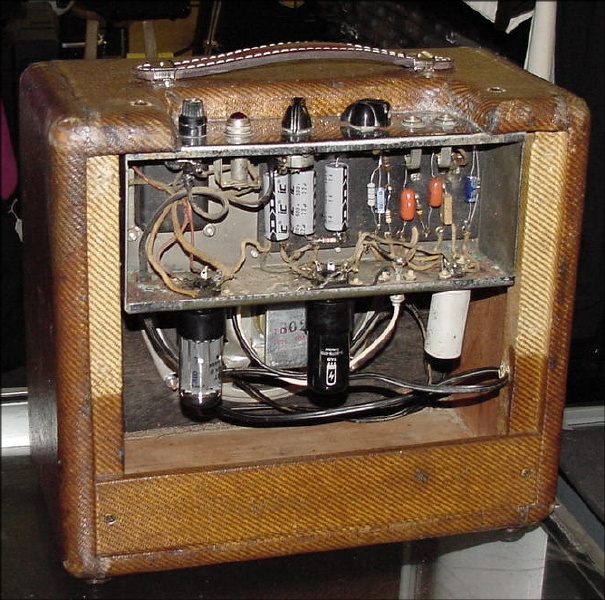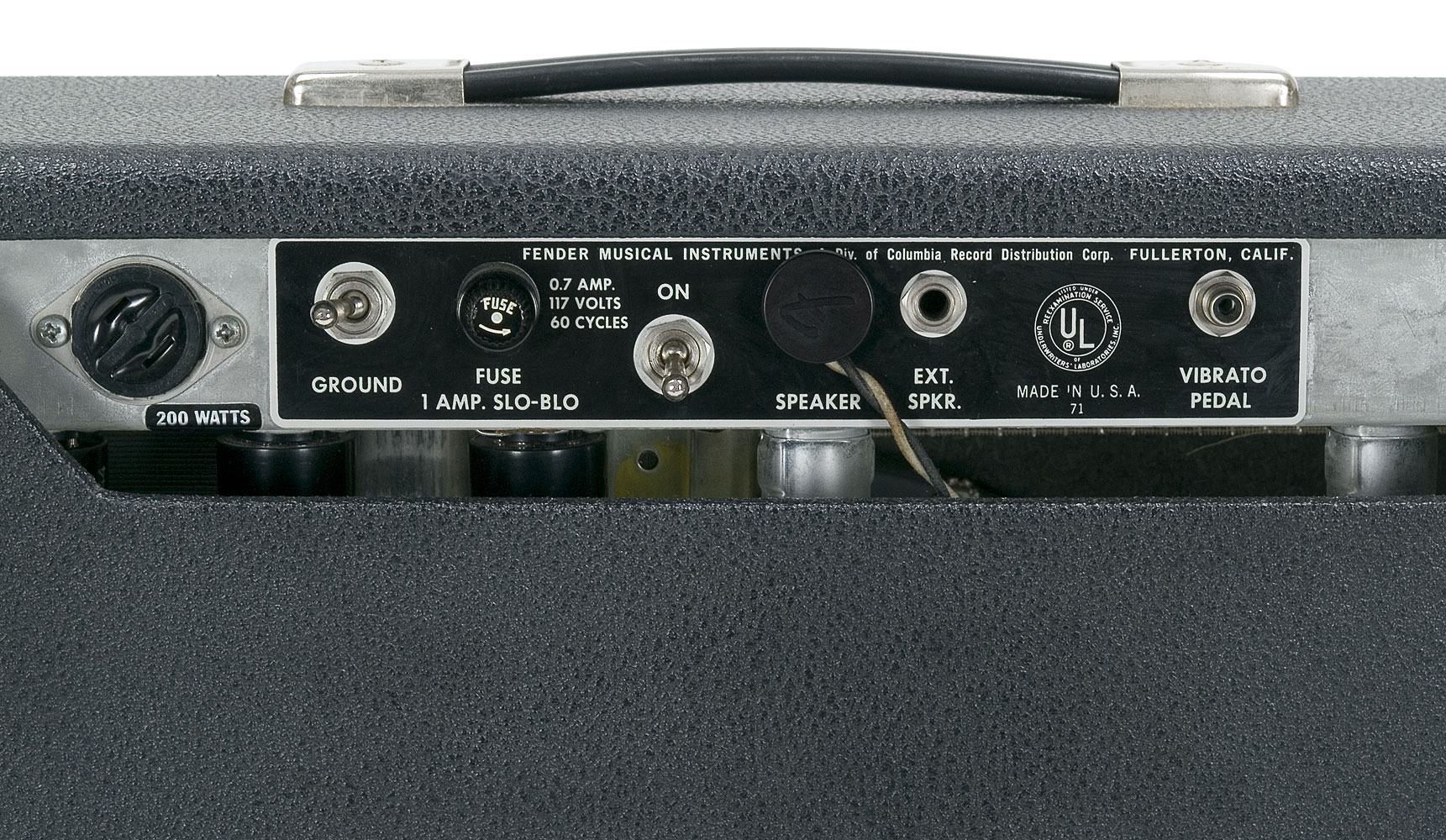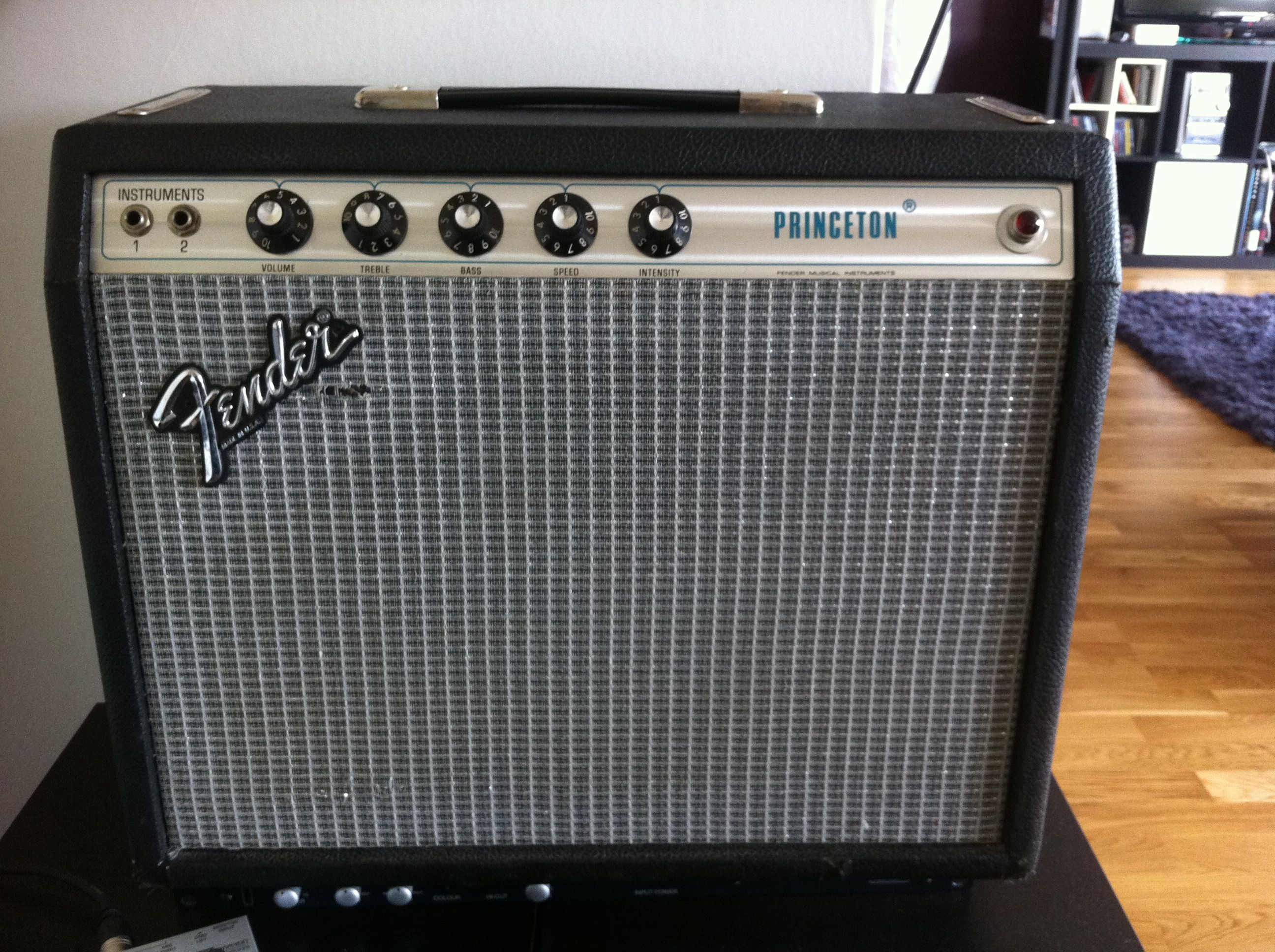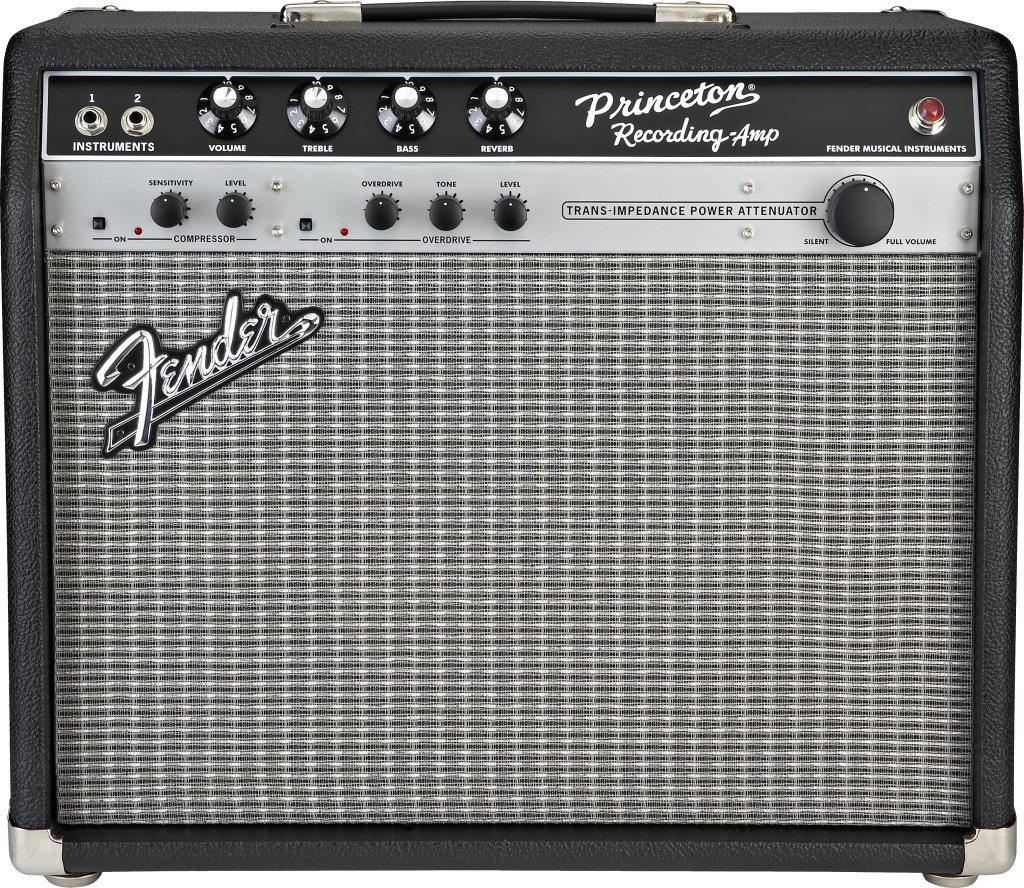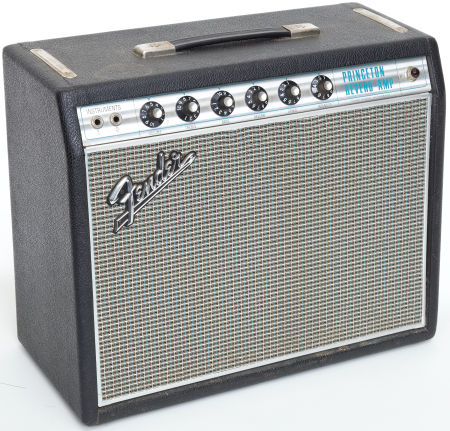 |
| The Evolution of the Fender Princeton Amplifier |
The Fender Princeton was introduced in 1947 and discontinued in 1979. It was one of the first amplifiers Fender offered, and in the line-up even before Fender’s smallest amplifier, the Champ, which was introduced in the 1948.
Fender Princetons and Princeton Reverbs are highly valued particularly as great recording amplifiers. Jazz artists liked them two, since they were small, yet loud enough to be heard in a combo and had great headroom. Blues and rock guitarists like the early breakup of the 6V6 tubes.
It is funny since Leo Fender considered this to be a student amp, hence the name Princeton. In his original line-up he also offered the bigger and slightly louder Harvard amplifier.
 |
| 1947 Princeton "Woody" |
The power tube was a single 6V6. It had an instrument volume control, a mic volume control and a tone control, along with 3 inputs. This amp was produced through 1948 when it was replaced in by the TV front Princeton. Fender usually put their badge on the lower corner of the Woody amplifier.
 |
| 1949 Fender TV Front |
Again the came with an instrument volume control, a mic volume control and a tone control along with 3 input jacks. This amp continued through production from 1948 through 1953 when the Wide Panel Princeton replaced it.
The badge was placed on the top front side of this amp, and would remain in this position on subsequent amps until Fender came along with their front panel line.
 |
| 1953 Wide Panel Princeton |
The tube configuration was a little different as well. Fender used either the 6SL7, or a 5B2/5C2/5D2 or a 12AX7; whatever was available. The Power tube could be a 5B2, 5C2, 5D2, a 6V6 or a 6V6GT.
Once again the rectifier tube was a 5Y3, but it could also be a 5B2, 5C2, 5D2 or a 5Y3GT. The changes caused a slight increase in wattage to 4.5 watts. The amp controls and fuse were now on the amps top control panel. This amp had an instrument volume control, a mic volume control and as on/off throw switch. This amp was in production until 1955 when Fender redesigned it to the become the Narrow Panel Princeton.
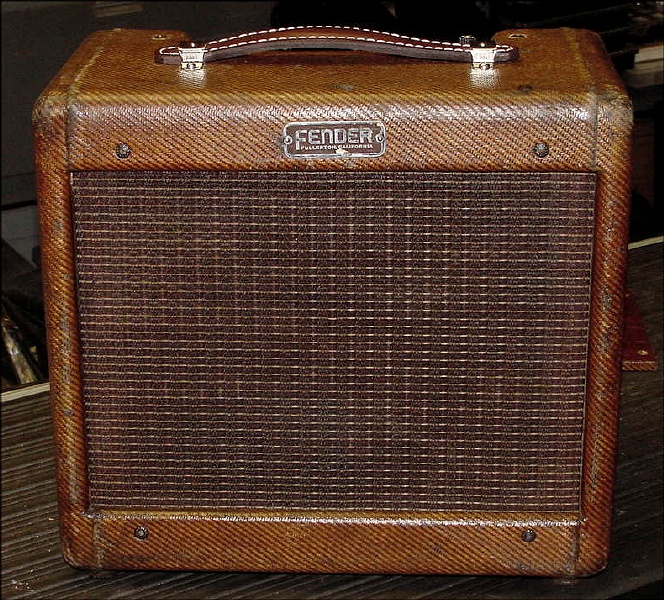 |
| 1955 Narrow Panel Princeton |
By this time Fender had settled on a 5Y3 rectifier, 6V6GT power tube and a 12AX7 preamp tube. It is interesting that the initial models utilized a “choke”, which was a small transformer attached to the speaker to act as a filter usually to minimize bass response so the speaker wouldn’t rattle.
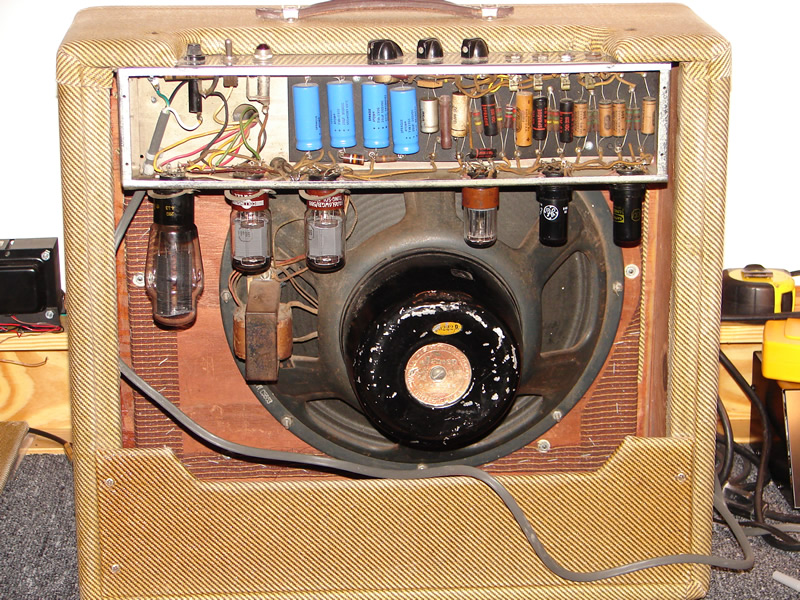 |
| Speaker with a choke transformer |
The Brown Princeton amp was the first step Fender took in modernizing its design. The control panel was on the front of the amp. The wooden chasis was covered in brown tolex. The speaker grill material was a color usually described as wheat.
The Brown Princeton amplifers power rating was dramatically increased to 12 watts, which powered a 10” Jensen C10R or an Oxford 10J4 speaker. The front facing control panel was painted brown and the knobs were also brown. The amp feature hi and low gain input jacks, a volume control, a tone control as well as speed and intensity controls for the built-in tremolo circuit.
This amp was no longer cathode based, but non-adjustable fixed bias. The rectifier tube was a 5Y3, two 6V6 power tubes worked as class AB, two 12AX7 tubes acted in differing ways. Half of the first tube acted as a phase inverter, while the other half was for preamplification. Half of the second tube worked the tremolo, while the other half was utilized for preamplification. These amps were only manufactured from 1961 to 1963.
 |
| 1963 Princeton amp |
In late 1964 this was switch to silver sparkle grill cloth. Once again this was a class AB fixed, non-adjustable bias amplifier. It was powered by two 6V6GT tubes operating in push-pull mode. The rectifier was a 5Y3 tube.
The main preamp tube was a 7025. And two 12AX7 tubes split the load between phase inversion, preamplification and the tremolo circuit. The first model had the same control panel as the Brown version, although the control plate on this amp was black with white lettering. The knobs on it were white.
 |
| 1964 Princeton amp |
Perhaps it was the lack of a reverb driver, that provided this amp with exceptional headroom. The Blackface Princeton amp could be cranked up to 7 or 8 on the volume and still produce a clean sound.
 |
| 1964 Princeton Reverb |
The rectifier was usually a 5Y3 tube, but substitutions were used, so it could be a GZ34 or a AA763 or a AA964. The twin power tubes were once again 6V6GT’s. The phase inverter was half of a 12AX7 and the other half was used for preamplification.
 |
| 1964 Fender Princeton Reverb |
 |
| Hammond Reverb tank |
 |
| Note the Ground Switch on the left |
Back in the days where buildings only had two prong receptacles and amps had two prong plugs, if you got a shock from touching a microphone or another anything else the way to solve it was pulling the electrical cord from the wall receptacle, reversing the plug a half turn and placing it back in the receptacle.
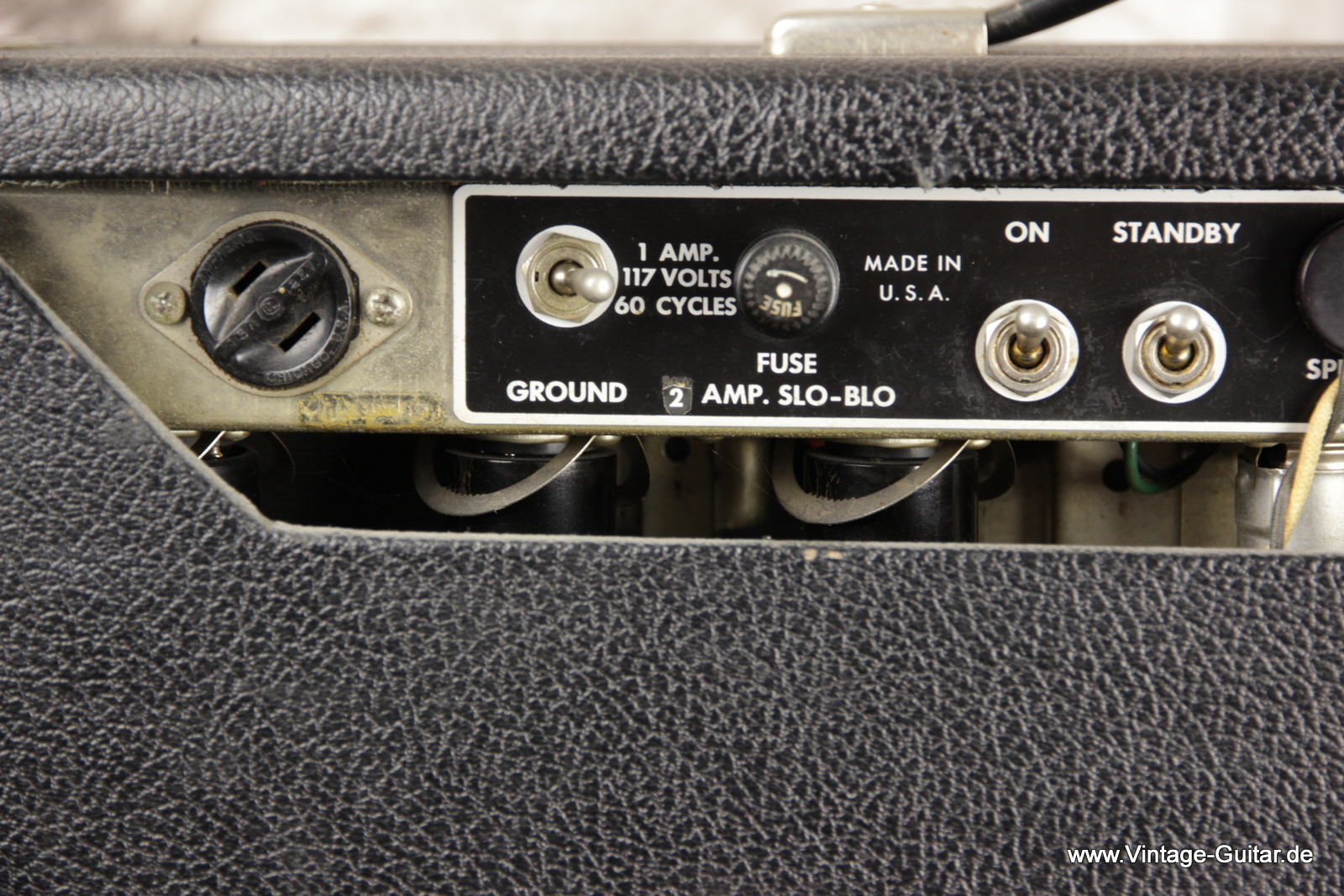 |
| BF Princeton with AC plug |
The back panel of these amps had a 1/4” plug for the speaker and another input for an external speaker. They were also equipped with inputs for the reverb/tremolo pedal and the reverb out/send.
The Black face Princeton Reverb was produced from 1964 through 1967.
 |
| 1966 Princeton Reverb |
CBS/Fender’s first major change was to change the control panel from black with white script to silver with blue (or in some cases red) lettering.
 |
| 1968 Princeton amp |
The power tubes remained dual 6V6GT’s, always a Fender favorite. A 7025 was used for the preamp and half of a 12AY7 served double duty for the preamp circuit, with the other half used as a phase inverter for the power tubes. Another half of a 12AY7 was used for the tremolo circuit. This amp pumped 12 watts into a 10” Oxford 10J4.
Initially in 1968 this amp had a blue sparkle grill cloth with an aluminum frame. The grill cloth remained, but the aluminum frame was gone on 1970 models. From 1976 to the end of the run the grill cloth was orange and silver.
The Fender badge with the “tail” was mounted on the side of the amp from 1968 through 1974. Mid 1974 and after the badge was changed so the the tail was removed.
The control panel featured hi and low gain inputs, volume, treble, bass, speed and intensity potentiometers topped with Fender skirted knobs. The initial rear panel featured the courtesy plug, the fuse, a “ground” switch, an on/off switch, the speaker input, an external speaker input, and the vibrato jack for a footswitch.
Later in the run the ground switch was replaced with a 3 position throw switch.
 |
| 1968 PR with aluminum frame |
The tube complement was similar to the reverb(less) model. The GZ34 was the rectifier until 1970 when it was replaced with the 5U4GB. Once again the power tubes were twin 6V6GT’s. A 7025 acted as the preamp tube. One half of a 12AY7 was used as the other part of the preamp circuit, while the remaining half served as the amp’s phase inverter.
Another half of a 12AY7 was used for the tremolo, and one 12AY7 was used as a reverb driver, with a half of a 12AY7 being used for reverb recovery.
This amp pumped 12 to 15 watts into either a 10” Oxford 10J4 or a CTS (Chicago Telephone Supply) 10” speaker. The grill cloth material used on the Princeton Reverb was the same as used on the Princeton amp and was changed in the same time frames listed above. The control panel was comprised of a hi and low gain input jack, volume, treble, bass, reverb, speed and intensity potentiometers and a pilot light.
The rear panel included the courtesy plug, a “ground” switch, a fuse, the on/off switch, the speaker jack, an external speaker jack, inputs for the vibrato and reverb footswitch, the reverb send and reverb receive jack. The reverb unit was also in a pouch on the floor of the chassis. This amp was available through 1981.
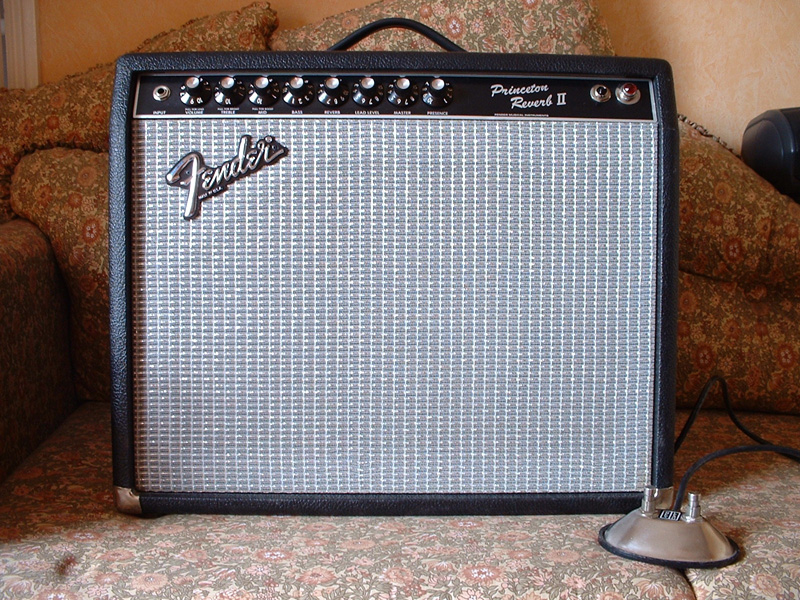 |
| Princeton Reverb II |
This amplifier and the circuitry were designed by the legendary Paul Rivera. And it was a much different amp than all of the previous models. In fact Rivera created a whole new line-up of Fender tube amplifiers.
For one thing the rectifier was solid-state. Two 6V6GTA tubes provided power for this amplifier. The preamp tube section included a 7025 as a phase inverter, with half of it used for the preamp. One12AX7 tubes completed the preamp section and one more 12AX7 was used to drive the reverb and for lead distortion.
Another 12AX7 was used as a reverb pickup and the final preamp section. However these tubes could be 12AY7’s or ECC83’s or ECC81’s The speaker was beefed up to a Fender Special Design 8 ohm 12” model to accomodate this amps 20 watt output.
The chasis was still black tolex, but the silver control panel section was once again black with white script.
The potentiomer knobs were the Fender skirted style with chrome centers. One thing that made this amp so special was the channel switching capability. The front facing control panel included a single input for guitar, a volume control that you could pull forward for lead. Next in line was the treble control. When pulled forward it acted as a bright control.
In 2006, Fender revived the Princeton name for a tube amplifier creating a rather unusual amplifier called the Princeton Recording-Amp in their Pro-tube series. This was essentially a blackface Princeton Reverb with an additional section of chassis which housed a built-in overdrive, compressor and a power attenator.
That same year they issued the Princeton 650 in the Dyna-touch III series. This was a solid-state amp with lots of bells and whistles.
In 2008 Fender reissued an updated version of the '65 blackface Princeton Reverb.
Fender has also offered an updated version of the '68 silverface Princeton Reverb. These amps are still offered in the Fender line-up
It is interesting that the Princeton amp was the basis for Randall Smith’s creation, the Mesa Boogie Mark 1.
 |
| Smith's original modified Princeton |
This is Kenny Vaughn and his SF Princeton Reverb



